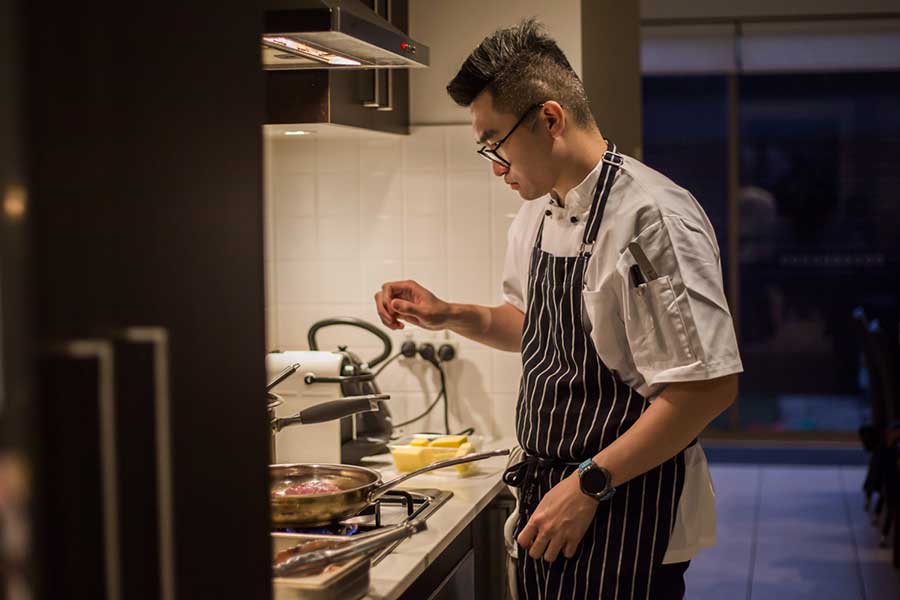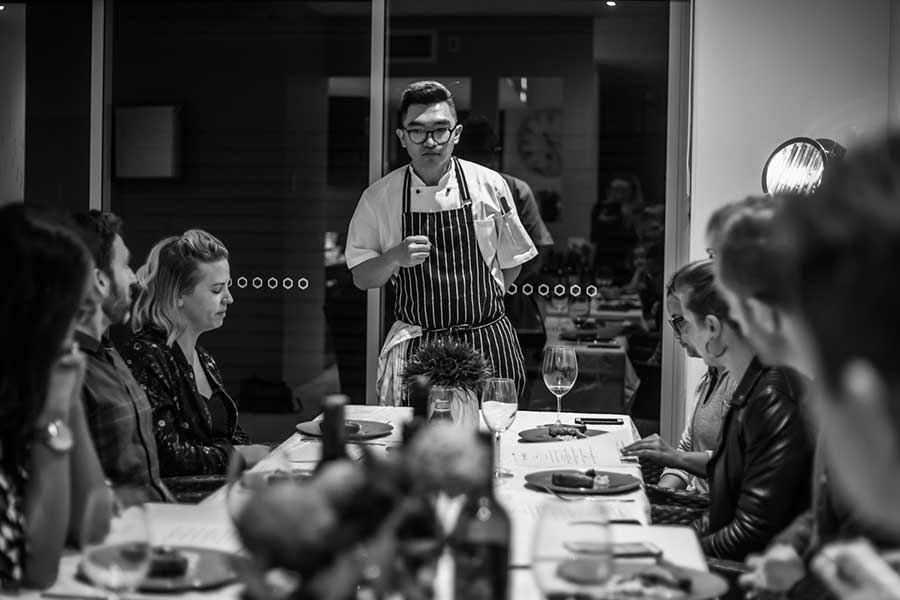Though small in size, crafting canapés is a challenging endeavour. It often requires hours, or even days, to produce something enjoyed in seconds. A chef meticulously considers each component of a canapé before it reaches your plate, showcasing its artistry. Despite their diminutive nature, canapés are intricate and creative expressions of a chef’s skill, seamlessly blending colour, flavour, and texture into a stunning presentation.
Home cooks can also create impressive canapés by following similar principles and techniques.
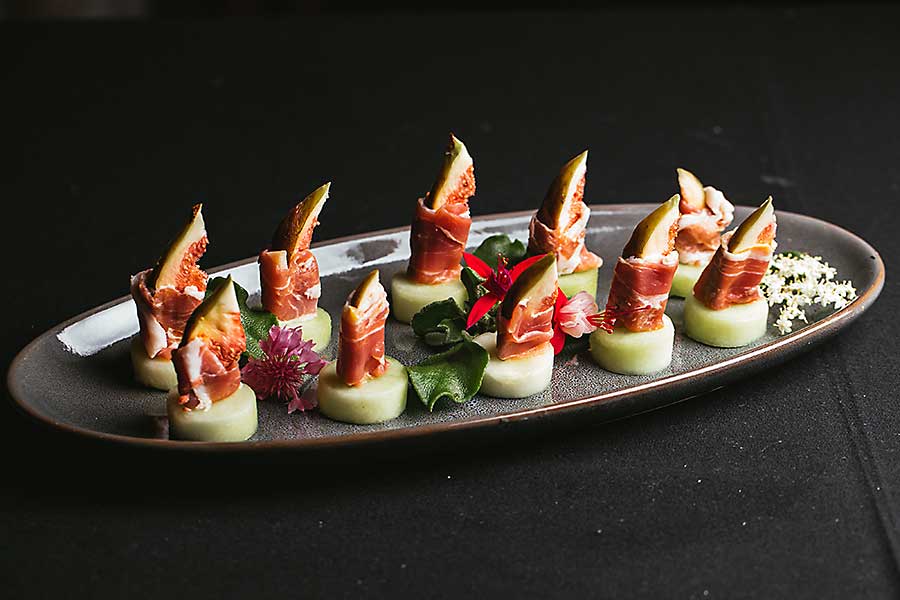
As The Independent says, “Each small mouthful [of a canapé] is a chance for the chef to exhibit limitless culinary trickery”. But what’s the process behind this complex canapé creation? Here’s a behind-the-scenes look at how chefs develop the decadent morsels we call canapés.
What is a canape?
Canapés are small pieces of food traditionally served before (or instead of) dinner and designed to be easy to eat. They can usually be consumed in just one or two bites, with little mess or effort. Canapés can also be deep fried, offering a delicious and crispy texture. Most canapés consist of a base of bread or pastry topped with various ingredients and flavourings. You’ll often see canapés paired with cocktails, as you can eat them while holding a drink in your other hand. That’s why they’re the perfect type of catering for a cocktail party.
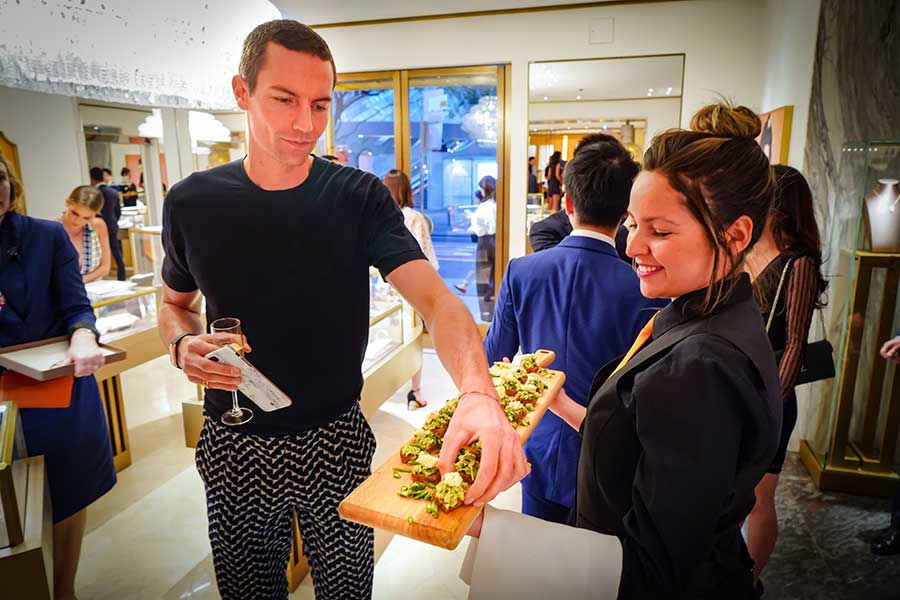
What is the history of canapés?
The word canapé comes from the French word for sofa. But we’re not talking about slouchy leather sofas in your living room – we’re talking about those elegant sofas you’d see in the Palace Versailles, with delicate metal legs and arms and beautiful upholstery. So, you can imagine the kind of elite imagery a canapé evokes.
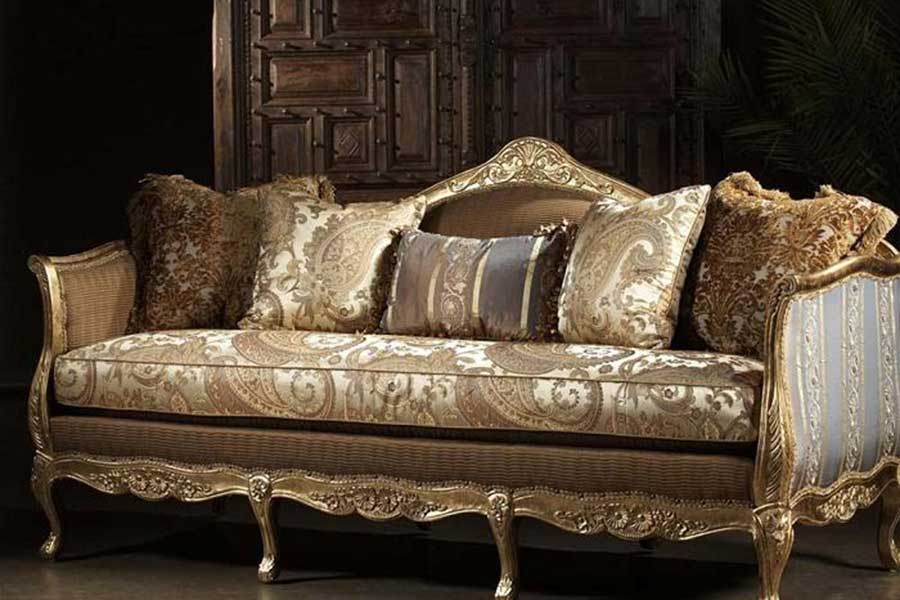
They first originated in the mid-1800s after a chef experimented with hors d’oeuvres and put savoury toppings on a piece of bread. So why the term canapé? The topping on the bread was like someone sitting on a sofa… oh, the obscurity of it all!
What’s the difference between canapés and hors d’oeuvres?
Many people wonder how canapés differ from hors d’oeuvres or other finger foods. That’s easy: canapés are a type of hors d’oeuvre. Hors d’oeuvres in French means ‘outside of work’, so hors d’oeuvres in their traditional sense refer to any snack served outside the main meal. That makes canapés a type of hors d’oeuvres that consists of a base layer and a topping. Sometimes, people will use the terms interchangeably, but all you need to know is that they’re both a type of finger food eaten while standing up.
When planning an event, it’s important to consider how many canapés to serve per person. Four to six canapés per person is recommended for a one-hour drinks reception. For longer parties or sit-down dinners, the number of canapés should be adjusted according to the duration and nature of the occasion. Proper planning ensures that guests are satisfied and the event runs smoothly.
What are the different parts of a canapé?
A canapé always consists of a base and a topping. It can also include a sauce or spread and a garnish.
- A canapé’s base is usually a small piece of bread or toast, a pastry shell, a blini, or a cracker.
- The spread of a canapé helps add moisture and flavour while also preventing the base from going soggy. It also allows the toppings to ‘glue’ onto the bread and prevents them from slipping off. Popular spreads for canapés include butter, mayonnaise, or cream cheese.
- The main attraction of a canapé is its topping. This could be absolutely anything, from a fruit or vegetable to a type of seafood or a cut of meat. Since canapés are often associated with luxury, more premium ingredients tend to be used for toppings. Picture smoked salmon, wagyu beef, prosciutto, lobster, or prawns.
- Some canapés will also have a garnish, so why not? The garnish could be anything from a sprig of herbs to caramelised onions or caviar.
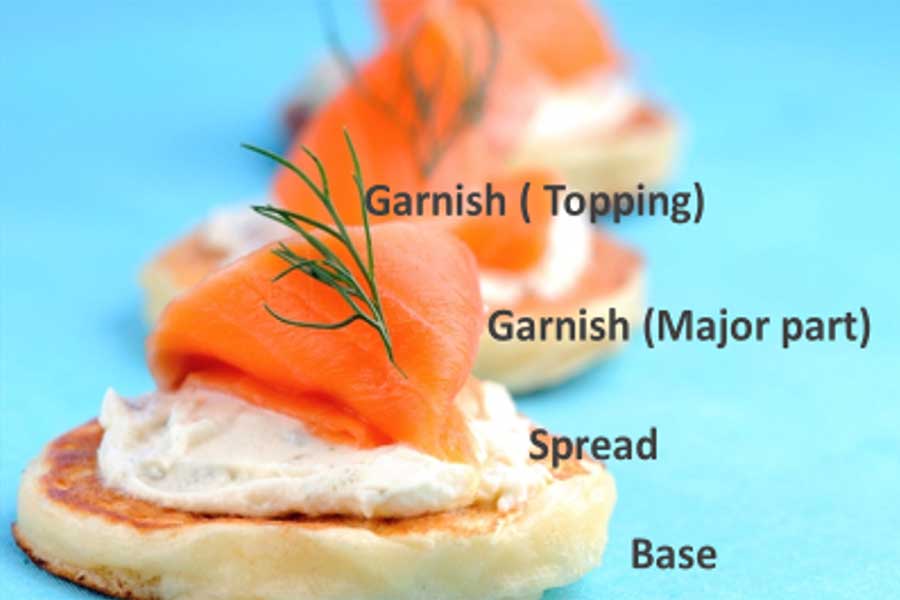
What makes a successful canapé?
Although all canapés are made from the same foundation of base, spread, topping, and garnish, that doesn’t mean they all taste or look the same. Your frozen supermarket canapés won’t be nearly the same calibre as a chef-made canapé (no offence to supermarkets). This is where being skilful makes all the difference – some canapés are good, and there are canapés that blow people’s minds. Two main factors contribute to a successful canapé. Additionally, planning the number of canapés per person is crucial to ensure guests are satisfied without overindulging.
Balancing colour, flavour, and texture
These three elements are paramount to creating canapés that are memorable and inviting. The texture is important to consider – a successful canapé contrasts several textures to create an enjoyable eating experience. A canapé shouldn’t be too much of any one texture, for example, too soft, too creamy or too crunchy. It should perfectly harmonise various textures for an interesting eating experience.
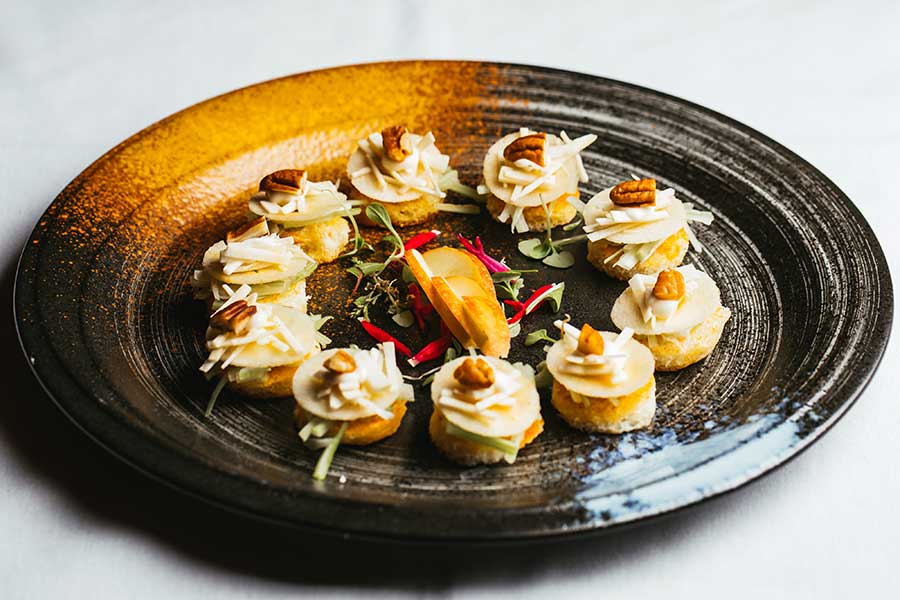
Having a variety of colours in a canapé makes it more attractive and inviting, especially if it’s presented on a buffet table for people to help themselves. Using colours correctly can transform a canapé into a work of art. Taste, well, of course! A successful canapé has to taste good!
-
 Omakase Dining at home$445.00
Omakase Dining at home$445.00 -
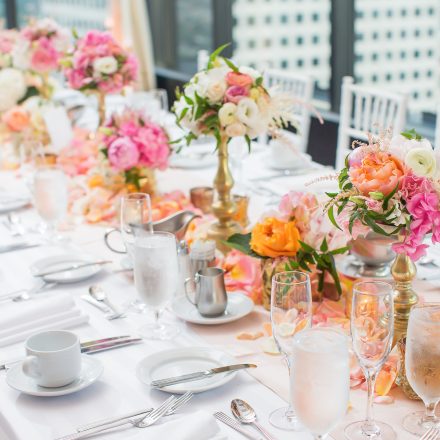 Degustation with 12 Courses$395.00
Degustation with 12 Courses$395.00 -
 Cocktail Canapés$65.00
Cocktail Canapés$65.00
Ease of eating
One of the most important parts of a canapé is how easy it is to eat. Canapes are designed to be consumed with the hands while standing up, and usually with a drink on the other hand. So a successful canapé can easily be eaten with one hand and usually in one bite. It must not fall apart if it takes more than a single bite to eat the canapé. A successful canapé doesn’t leave sauce on the hands and isn’t messy to eat. It should be swiftly consumed in one or two bites, and that’s the end of that…
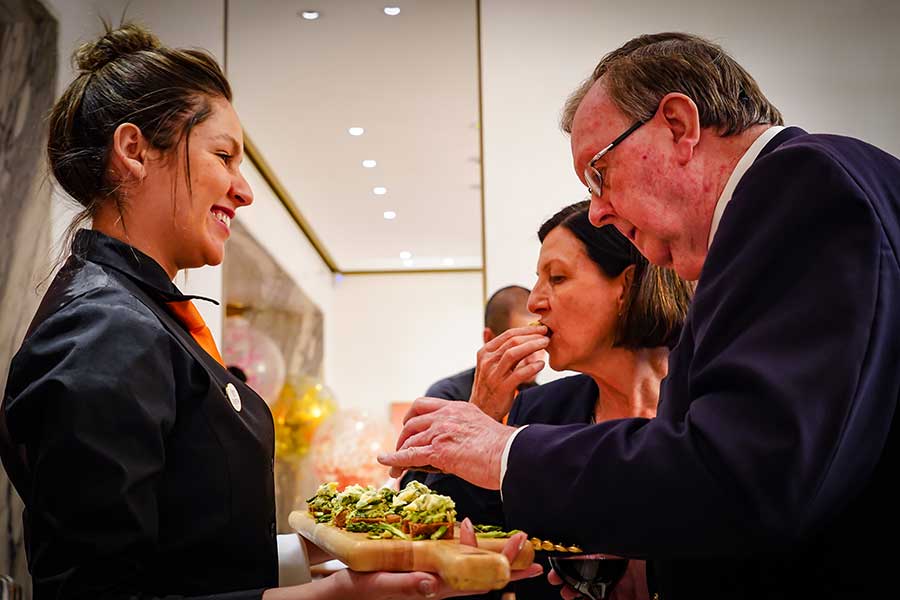
What are typical canapé garnish ingredients?
Adding garnish to a canapé can give it an extra wow factor. They add a decorative touch but also a hint of extra flavour, whether that’s heat, saltiness or sweetness. Here are some different garnishes used on canapes:
- Shaved truffles,
- Cornichons,
- Caviar,
- Capers,
- Chopped olives,
- Lemon zest,
- Caramelised onion,
- Chopped herbs,
- Crushed nuts,
- Microgreens,
- Sliced cherry tomatoes.
What are some different types of canapes?
So, what can you expect when you order canapés? These are some examples of popular canapés to give you an idea of the different types of canapes a chef might make:
- Porcini, shiitake, and cremini mushrooms with Gruyere cheese on a base of polenta topped with minced thyme,
- Caramelised asparagus and shallots with cream cheese on a base of crispy toast topped with toasted walnuts and lemon zest,
- Smoked salmon with horseradish cream cheese on sliced cucumber topped with chopped fresh chives,
- Black olive tapenade and fresh crumbled goat cheese on a crispy base topped with fresh thyme leaves,
- Sliced peach and prosciutto and lemon-shallot mascarpone cream cheese on a sliced baguette topped with fresh chopped basil,
- Fresh cranberries, ginger, coriander, and jalapeños with goat cheese on crunchy toast topped with roasted pumpkin seeds.
Now that we know what makes up a canapé, here’s a behind-the-scenes look at how chefs design and make them, from concept to creation.
Step 1: Creative brainstorming
Every canapé a chef creates starts with the client or event. The client’s ideas or needs, budget, guests, type of celebration, theme, and venue are all considered. Knowing where the canapé will be eaten plants the seed for a chef who will then get busy brainstorming a creative menu that’s indulgent, Instagrammable, and bound to impress the guest list.
This brief from the client will form the base of a chef’s canapé recipe. The chef will merge the initial ideas with the culinary trickery and techniques they’ve picked up throughout their career. Every chef has a different skill set, is versed in other cuisines, and brings their artistry to the table, so canapés will always reflect the chef.
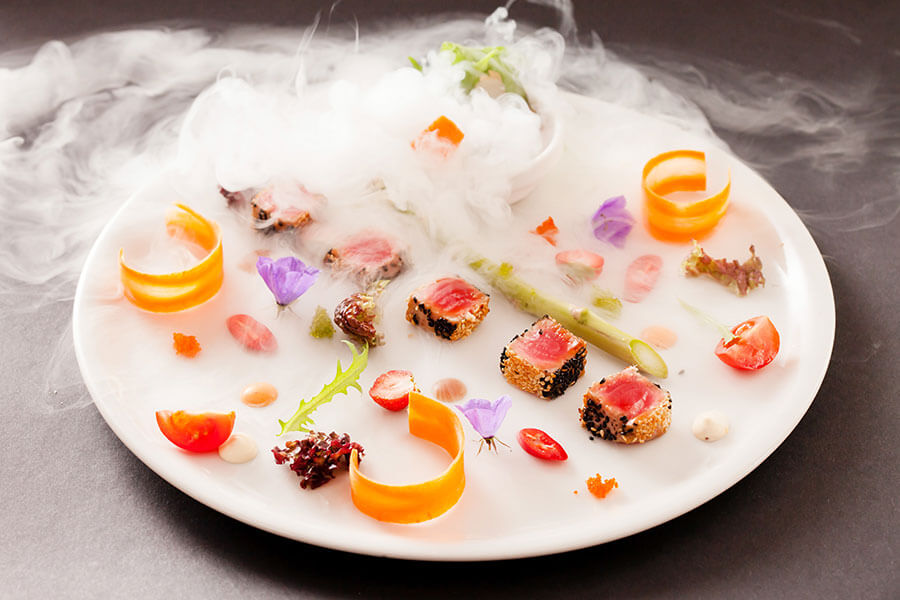
Food doesn’t just fall onto the plate like this naturally. It takes meticulous design, consideration, and effort.
Step 2: Sourcing fresh, gourmet ingredients
The flavour doesn’t just come from a combination of spices and seasoning. The best flavour comes from within, and most chefs will go straight to the source when shopping for their canape ingredients. The secret sauce to any mouth-watering dish is the ingredients’ freshness, and most chefs look for produce that has reached peak flavour and maturity.

Farmers’ markets, fish markets, delicatessens, bakeries… it’s funny how shopping for something so small can take hours or days of attention.
Shopping for canapes isn’t as simple as checking the list and grabbing the number of vegetables needed. It’s an uphill task of inspecting every item, smelling it, feeling it, and getting a good sense of ripeness before putting it in the basket. You’d better bet that a chef’s inventive recipe will not be wasted on a less-than-incredible vegetable or seafood.
Chefs’ time in markets doesn’t just involve picking ingredients and assessing their quality. A lot of effort goes into building relationships with store owners. Having a good rapport with the staff at a fish market means the chef will get the freshest and best salmon of the day. If the chef knows the farmer well, they’ll save them the ripest pick of the bunch each time.
Chefs spend much time getting to know their producers and building relationships to ensure customers receive premium ingredients and delicious canapés.
Step 3: Slicing, dicing, and prepping
Canapes are complex. The amount of ingredients and preparation that can go into a single bite-sized piece of art is astounding. That dollop of sauce? It could have taken hours to cook. There’s making the broth for the sauce, chopping the ingredients, boiling it down, thickening it, refrigerating it… and then each canape may end up with only a few drops—extremely flavoursome drops, but still.
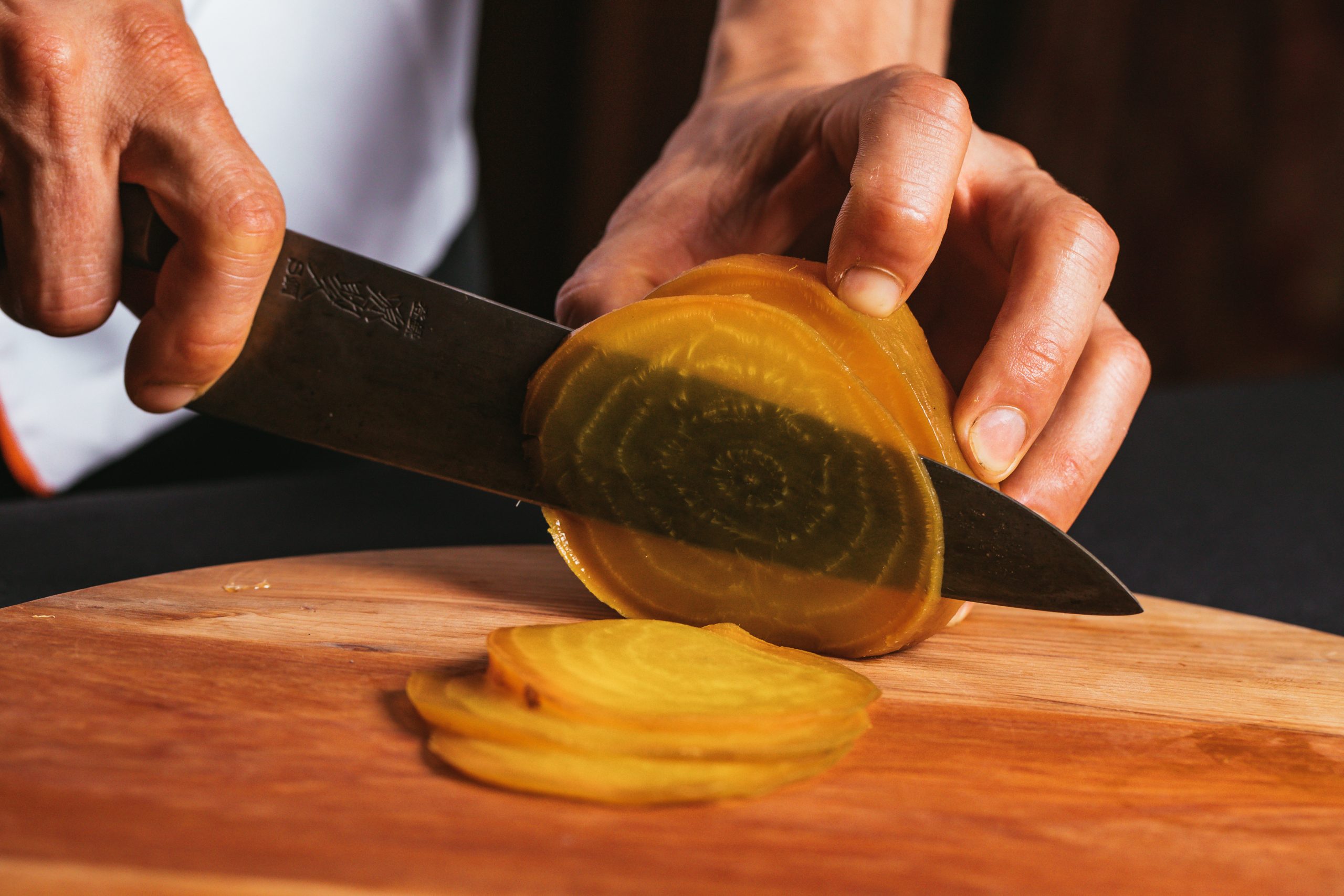
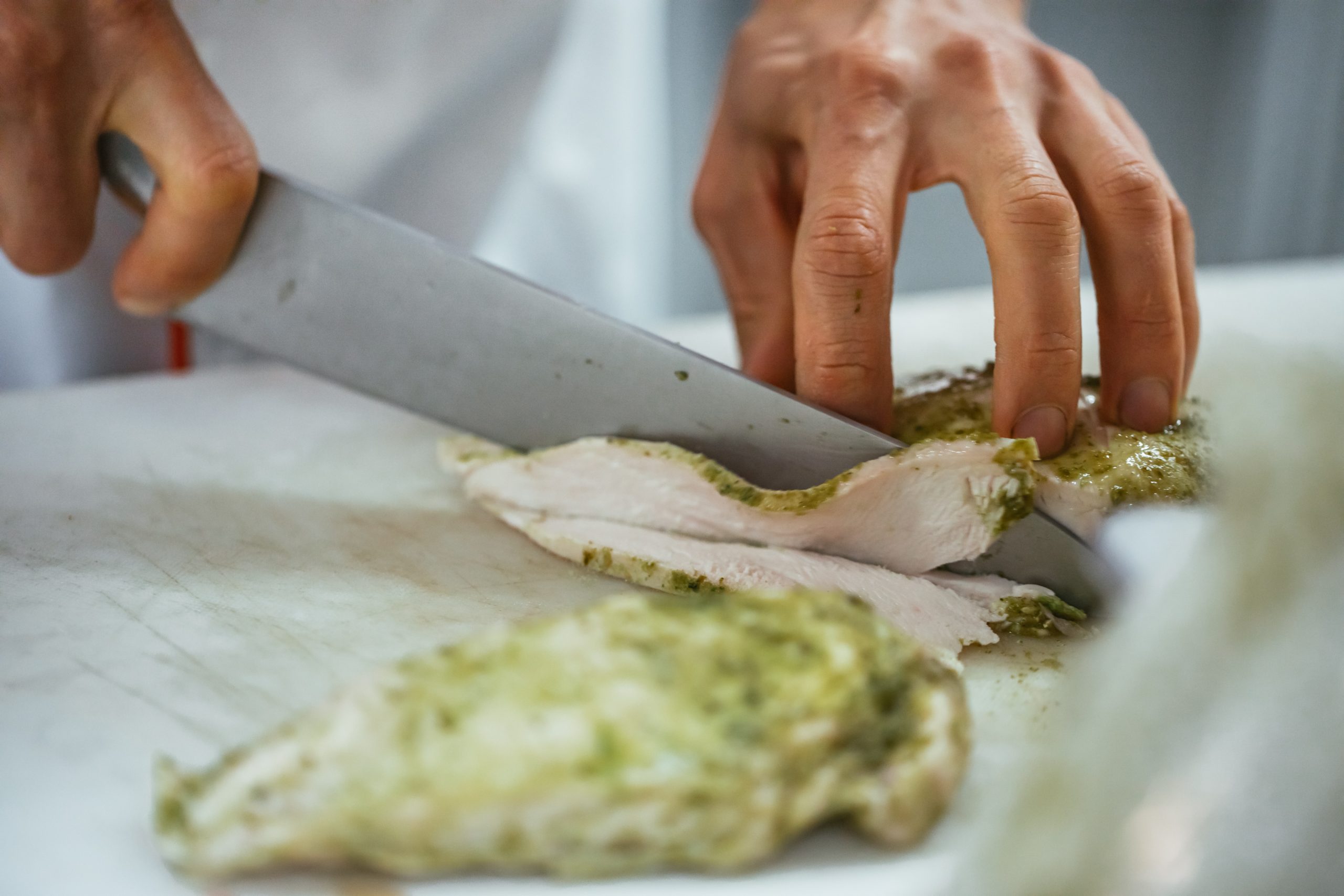

Every ingredient in the tiny flavour bombs that are premium canapés requires precise chopping, slicing, dicing, and prepping. Some ingredients are roasted, while others are fried. Some are steamed, while others are experimented with and turned into foam. Some require freezing, others require toasting. Some are glazed, others reduced.
Canapé creation is about balancing every delicate ingredient’s unique needs and aspects and bringing them together seamlessly. It’s no easy feat. Next time you pop an appetiser in your mouth, stop and appreciate all the effort into that end product. Relish it.
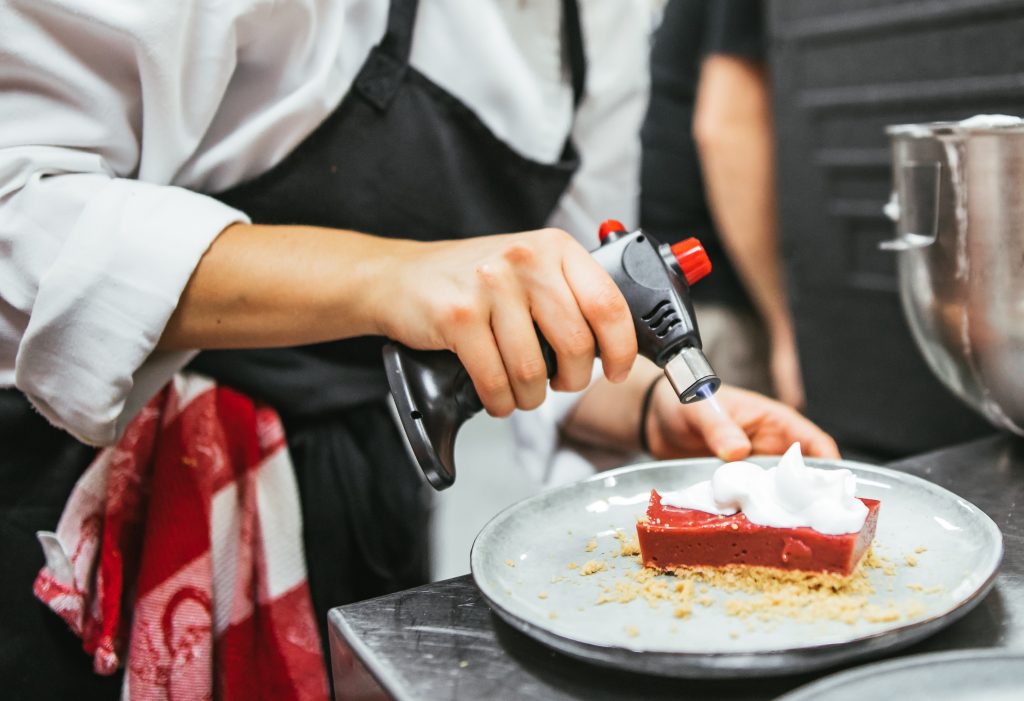
Step 4: Plating up
People love to watch the plating process the most. Why? because plating is a true art and an absolute joy to witness.
It’s the final coming-together of all the exquisite ingredients and elements of the canapé. Plating up is about precision, structure, focus, and meticulous design. This is where a chef can truly showcase their mastery in their craft, presenting their dishes with real aesthetics while also sticking to the easy-to-eat finger food rule of premium canapés.
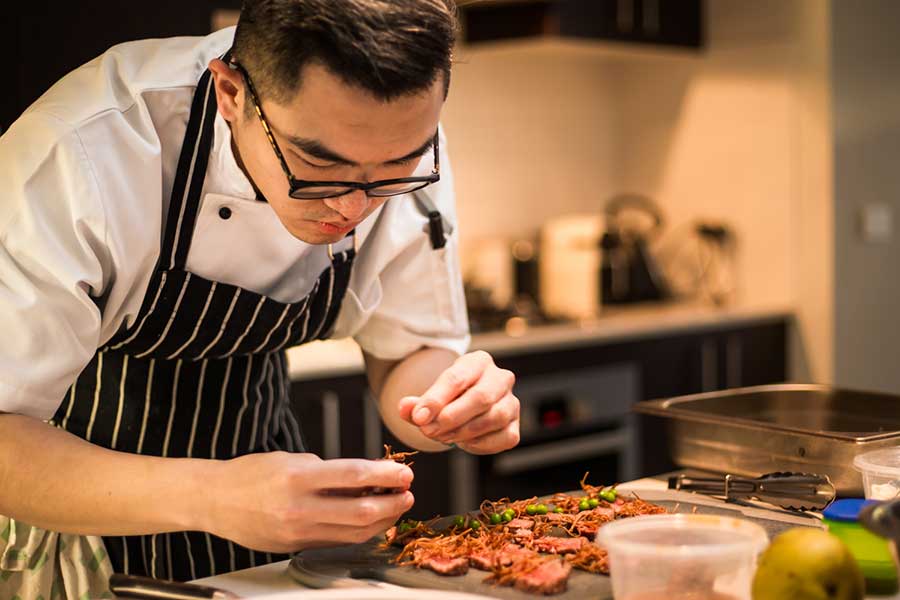
Thin slices can be wrapped or overlapped to create a pattern. Moulds help sauces, creams, and purees retain texture and shape. Plating up is all about creating composition, a sense of elegance and intrigue, and premium canapés that are extremely Instagrammable.
Best Practices for Making Canapés
Regarding canapés, there are several best practices to keep in mind to ensure that your creations are delicious and visually appealing. Here are some tips to help you get started:
- Use fresh and high-quality ingredients: The key to making great canapés is to use fresh and high-quality ingredients. Choose seasonal produce, fresh herbs, and high-quality meats and cheeses. The freshness of your ingredients will shine through in the final product, making each bite a delightful experience.
- Keep it simple: Canapés are meant to be bite-sized, so keep your ingredients and flavours simple. Avoid over-complicating your canapés with too many ingredients or flavours. A well-chosen combination of two or three elements can create a harmonious and memorable taste.
- Use the right bread: The bread is the foundation of a canapé, so choose a sturdy bread to hold your toppings. Baguette slices or puff pastry are great options. The bread should complement the toppings without overpowering them, providing a perfect base for your creations.
- Don’t overdo it: Canapés are meant to be small, so don’t overload them with too many toppings. One or two toppings per canapé is plenty. This ensures that each bite is balanced and the flavours can be fully appreciated.
- Pay attention to texture: Texture is important when it comes to canapés. Mix crunchy, soft, and creamy textures for an interesting and engaging bite. Various textures will make your canapés more enjoyable and keep your guests coming back for more.
By following these best practices, you’ll be well on your way to preparing canapés that are delicious and visually stunning.
-
 Omakase Dining at home$445.00
Omakase Dining at home$445.00 -
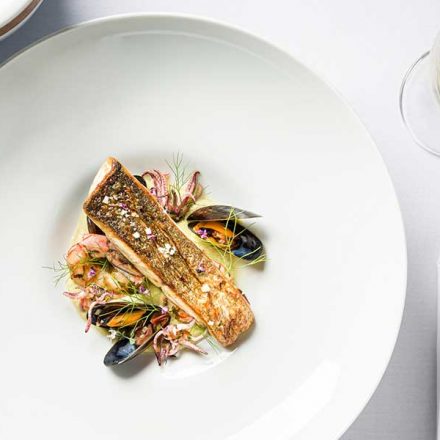 5-Course Fine Dining$245.00
5-Course Fine Dining$245.00 -
 Cocktail Canapés$65.00
Cocktail Canapés$65.00
Common Canapé Mistakes to Avoid
While making canapés can be a fun and creative process, there are several common mistakes to avoid. Here are some of the most common mistakes to watch out for:
- Using stale bread: Stale bread can be a major turn-off regarding canapés. Make sure to use fresh bread or toast to give it a crispy texture. Fresh bread will provide a solid foundation and enhance the overall taste of your canapés.
- Overloading the canapé: Too many toppings can make a canapé look messy and overwhelming. Keep your toppings simple and balanced. A well-composed canapé should be easy to eat and visually appealing.
- Not considering dietary restrictions: Make sure to consider nutritional restrictions when creating canapés. Offer vegetarian, gluten-free, and dairy-free options to cater to different needs. This ensures that all your guests can enjoy the canapés without any concerns.
- Not labelling your canapés: If you’re serving various canapés, label them so that your guests know what they’re eating. Clear labelling helps guests make informed choices and adds a professional touch to your presentation.
- Not serving canapés at the right temperature: Some canapés are best served hot, while others are best served cold. Ensure you serve your canapés at the right temperature to bring out the best flavours. Proper temperature management will enhance the taste and texture of your canapés.
By avoiding these common mistakes, you can create canapés that are delicious and impressive.
Creating a Canapé Selection
Creating a canapé selection can be a fun and creative process. Here are some tips to help you create a well-rounded and delicious selection:
- Consider the occasion: Different occasions call for different types of canapés. For example, a cocktail party might call for more finger foods, while a dinner party might call for more substantial canapés. Tailoring your selection to the event ensures that your canapés are appropriate and appreciated.
- Offer a variety of flavours: Make sure to offer a variety of flavours to cater to different tastes. Include sweet, savoury, spicy, and umami flavours to keep things interesting. A diverse flavour profile will keep guests engaged and excited to try each canapé.
- Consider dietary restrictions: As mentioned earlier, consider dietary restrictions when creating your canapé selection. Offer vegetarian, gluten-free, and dairy-free options to cater to different needs. This inclusivity ensures that all guests can enjoy your canapés.
- Keep it seasonal: Use seasonal produce to create canapés that are fresh and flavorful. This will also help to reduce your carbon footprint and support local farmers. Seasonal ingredients are often at their peak flavour and can elevate your canapés.
- Remember the presentation: Presentation is everything when it comes to canapés. Arrange your canapés in a visually appealing way to enhance the overall experience. A beautiful presentation will make your canapés more enticing and memorable.
By following these tips, you can create a canapé selection that is diverse, delicious, and visually stunning.
Making Canapés in Advance
While canapés are best served fresh, there are some ways to make them in advance to save time and reduce stress. Here are some tips for canapés prep in advance:
- Prepare your ingredients: Chop, slice, and dice your ingredients in advance to make assembly easier. Having everything prepped and ready to go will streamline the process and reduce last-minute stress.
- Assemble your canapés: You can assemble your canapés up to a day in advance, but make sure to store them in an airtight container in the refrigerator to keep them fresh. Proper storage will maintain the quality and taste of your canapés.
- Freeze your canapés: Some canapés can be frozen in advance to save time. Place your canapés on a baking sheet and freeze until solid. Then, transfer them to an airtight container or freezer bag for storage. This method is particularly useful for canapés served warm or hot, such as deep-fried.
- Reheat your canapés: If you’re serving hot canapés, reheat them in the oven or under the broiler until crispy and golden brown. Proper reheating will ensure that your canapés taste as good as freshly made.
- Keep it simple: When preparing canapés in advance, keep it simple. Avoid complicated ingredients or flavours that may not hold up well to refrigeration or freezing. Simple, well-chosen ingredients will maintain their quality and taste better when served.
By following these tips, you can make canapés in advance without compromising on quality or flavour, ensuring a stress-free and enjoyable experience for you and your guests.
How many canapes should you prepare?
Two to three canapés per person is adequate for a full-course dinner party. They serve as appetizers and require no additional preparation.
If you’re hosting a cocktail party without a dinner, plan for 4 to 6 canapés per person during the first hour, followed by 2 to 4 pieces per person for each additional hour afterwards. You would need 6 to 10 pieces per person for a two-hour party.
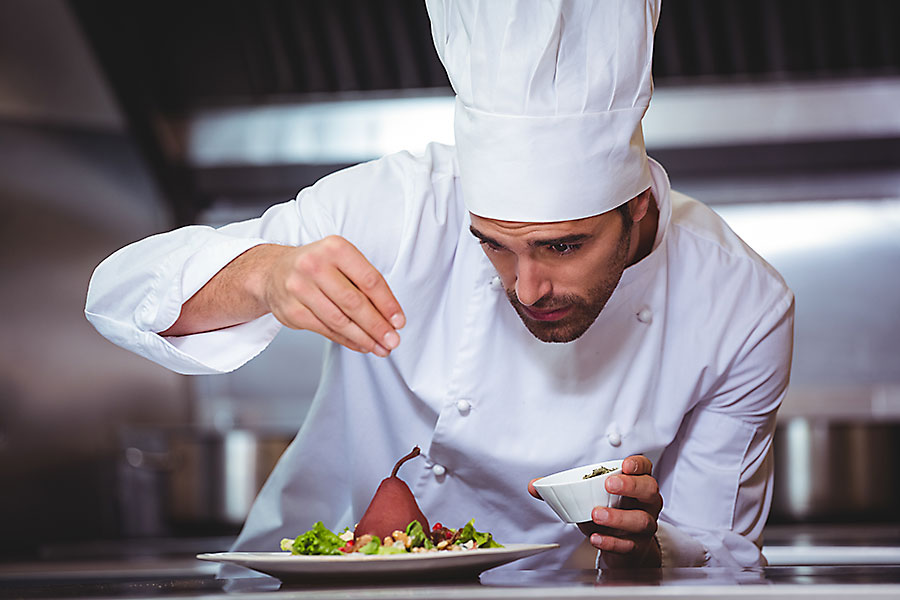
Fine Dining with A Private Chef
Private Chefs, Art of Dining
CHEFIN is a private chef platform that’s reimagining social dining.
You can easily connect with 1 of our 250 private chefs and treat your guests to restaurant-quality dining experiences in the comfort of your own home, office or chosen venue. From high-end dining to quirky social food experiences, the CHEFIN platform makes it effortless for you to access gourmet food that’s worthy of a Michelin-starred establishment.
What you get:
- Your very own private chef who is vetted and insured,
- A customised menu for your needs,
- 24/7 concierge support,
- Complete post-dinner cleanup,
- A fun, stress-free, and unforgettably dining experience!
